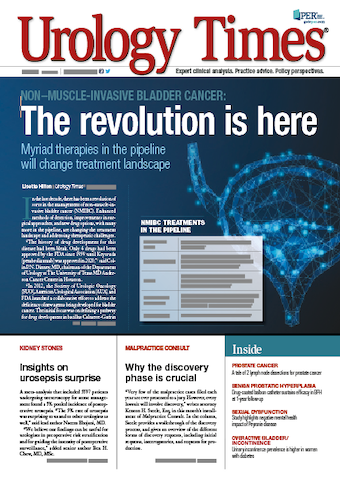Publication
Article
Urology Times Journal
Pivotal OAB data published for eCoin tibial neurostimulator
Author(s):
Ninety-eight percent of the study population was female.
Pivotal data for eCoin, a leadless tibial nerve stimulator for overactive bladder (OAB), have been published online in the Journal of Urology.1
The results from the primary efficacy analysis of an open-label, single-arm trial showed that eCoin met the primary end point of the study by achieving a ≥50% improvement in urgency urinary incontinence (UUI) in 68% of patients after 48 weeks of treatment.
“eCoin demonstrated clinical benefit for treating OAB with automatic delivery of an intermittent low-duty cycle and implanted with a minimally-invasive, brief procedure,” the authors wrote.
The eCoin device is a tibial neurostimulator that is the shape and size of a nickel. It is implanted in the lower leg under local anesthetic in an office or outpatient procedure by a urologist or urogynecologist. The procedure takes about 20 minutes.
Based on data from the trial, Valencia Technologies, the manufacturer of eCoin, previously submitted a pre-market approval to the FDA for use of the device in patients with OAB.2
Overall, the open-label, single-group assignment pivotal trial of eCoin (NCT03556891) included 133 patients with OAB with UUI. eCoin was a third- or fourth-line OAB therapy for these patients, who went through a washout period for any OAB medications. OAB drugs were not allowed during the trial.
There were 132 patients included in the intent-to-treat population. Baseline characteristics from these patients showed that the mean age was 63.9 years, 98% of patients were female, 84% were white, and the mean number of daily UUI episodes was 4.3. Based on patient reporting, the mean history of OAB was 11 years.
Device implantation was performed under local anesthesia and the mean time from initial incision to the final suture was 19.8 minutes. The primary efficacy end point was the rate of patients having a ≥50% improvement in UUI episodes as measured by a 3-day voiding diary at 48 weeks following activation of eCoin.
At 28 and 52 weeks, the rate of device-related adverse events (AEs) was 15%. AEs related to device or procedure were generally considered to be mild to moderate. At 52 weeks post-implantation, 19% of patients had AEs related to either the procedure or device. The specific incidence of device-related events at 52 weeks of treatment was 16%. There was 1 serious AE, consisting of an infection related to the study procedure. According to the investigators, this resulted in an explant, which investigators were able to resolve without sequelae.
“eCoin offers a novel OAB therapy with minimal compliance issues due to automatic therapy delivery and a well-tolerated, reproducible implantation procedure, all precipitating the potential for high adoption once available,” the authors wrote in their study conclusion.
References
1. Rogers A, Bragg S, Ferrante K, et al. Pivotal study of leadless tibial nerve stimulation with eCoin ® for urgency urinary incontinence: an open-label, single arm trial [published online April 2, 2021]. J Urol. doi: 10.1097/JU.0000000000001733
2. Valencia Technologies Files Pre-Market Approval (PMA) Application with U.S. FDA for eCoin Peripheral Neurostimulator. Accessed August 24, 2020.

Newsletter
Stay current with the latest urology news and practice-changing insights — sign up now for the essential updates every urologist needs.




























